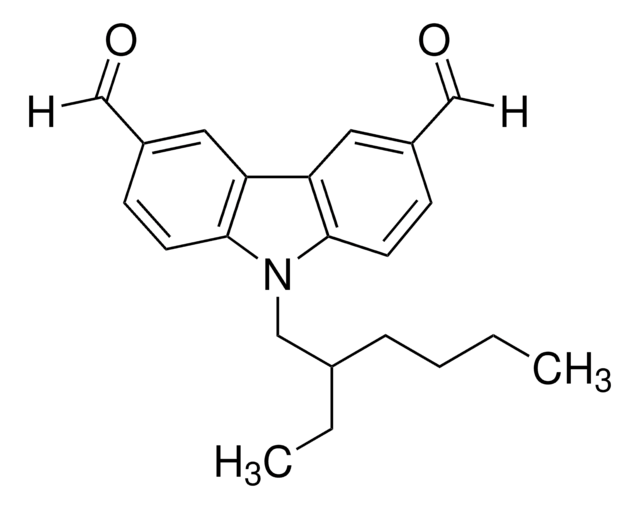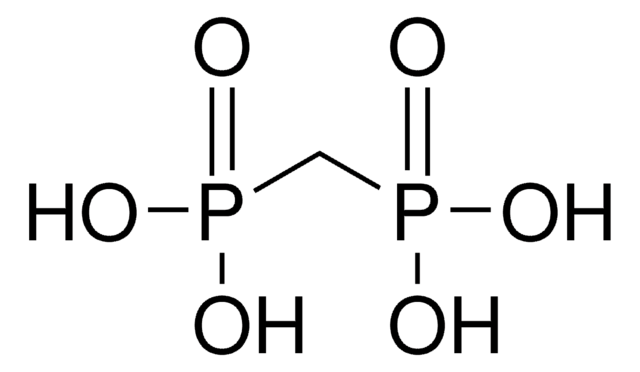68221
Abberior® STAR 440SXP, NHS ester
for long Stokes STED and 2-color STED application
Sign Into View Organizational & Contract Pricing
All Photos(1)
About This Item
UNSPSC Code:
12352108
NACRES:
NA.32
Recommended Products
Assay
≥80.0% (degree of coupling)
form
solid
mol wt
Mw 597.5 g/mol
solubility
DMF: 1 mg/mL, clear
fluorescence
λex 440 nm; λem 511 nm±10 nm in PBS, pH 7.4
storage temp.
−20°C
General description
Absorption Maximum, λmax: 433 nm (MeOH)
432 nm (PBS, pH 7.4)
Extinction Coefficient, ε(λmax): 36,000 M-1cm-1 (MeOH)
33,000 M-1cm-1 (PBS, pH 7.4)
Correction Factor, CF260 = ε260/εmax: 0.47 (PBS, pH 7.4)
Correction Factor, CF280 = ε280/εmax: 0.31 (PBS, pH 7.4)
Fluorescence Maximum, λfl: 502 nm (MeOH),
511 nm (PBS, pH 7.4)
Recommended STED Wavelength, λSTED: 590 − 620 nm
Fluorescence Quantum Yield, η: 0.57 (PBS, pH 7.4)
Fluorescence Lifetime, τ: 3.7 ns (PBS, pH 7.4)
432 nm (PBS, pH 7.4)
Extinction Coefficient, ε(λmax): 36,000 M-1cm-1 (MeOH)
33,000 M-1cm-1 (PBS, pH 7.4)
Correction Factor, CF260 = ε260/εmax: 0.47 (PBS, pH 7.4)
Correction Factor, CF280 = ε280/εmax: 0.31 (PBS, pH 7.4)
Fluorescence Maximum, λfl: 502 nm (MeOH),
511 nm (PBS, pH 7.4)
Recommended STED Wavelength, λSTED: 590 − 620 nm
Fluorescence Quantum Yield, η: 0.57 (PBS, pH 7.4)
Fluorescence Lifetime, τ: 3.7 ns (PBS, pH 7.4)
Application
- Abberior™ STAR 440SXP goat anti-mouse antibody has been used for STED (stimulated emission depletion) microscopy imaging of primary hippocampal cells.
- Secondary anti-mouse antibody conjugated with Abberior™ STAR 440SXP has been used for gated STED microscopy imaging of viral capsid.
- Abberior™ STAR 440SXP goat anti-rabbit antibody has been used for two-color STED microscopy imaging of olfactory epithelium.
Suitability
Designed and tested for fluorescent super-resolution microscopy
Other Notes
Legal Information
6538 is a trademark of American Type Culture Collection
abberior is a registered trademark of Abberior GmbH
related product
Product No.
Description
Pricing
Storage Class Code
11 - Combustible Solids
WGK
WGK 3
Flash Point(F)
Not applicable
Flash Point(C)
Not applicable
Certificates of Analysis (COA)
Search for Certificates of Analysis (COA) by entering the products Lot/Batch Number. Lot and Batch Numbers can be found on a product’s label following the words ‘Lot’ or ‘Batch’.
Already Own This Product?
Find documentation for the products that you have recently purchased in the Document Library.
I-Hsuan Wang et al.
Cell host & microbe, 14(4), 468-480 (2013-10-22)
Viral DNA trafficking in cells has large impacts on physiology and disease development. Current methods lack the resolution and accuracy to visualize and quantify viral DNA trafficking at single-molecule resolution. We developed a noninvasive protocol for accurate quantification of viral DNA-genome
Linda Westin et al.
BMC neuroscience, 15, 45-45 (2014-03-29)
Norbin is a neuron-specific, cytosolic protein that interacts with the metabotropic glutamate receptor 5 (mGluR5) and has a profound impact on mGluR5 signaling. Yet, little is known about its synaptic distribution. Here we have analyzed the spatial relationship between Norbin
Bastian Henkel et al.
Chemical senses, 40(2), 73-87 (2014-12-17)
Vertebrates can sense and identify a vast array of chemical cues. The molecular machinery involved in chemodetection and transduction is expressed within the cilia of olfactory sensory neurons. Currently, there is only limited information available on the distribution and density
Marcus Dyba et al.
Nature biotechnology, 21(11), 1303-1304 (2003-10-21)
We report immunofluorescence imaging with a spatial resolution well beyond the diffraction limit. An axial resolution of approximately 50 nm, corresponding to 1/16 of the irradiation wavelength of 793 nm, is achieved by stimulated emission depletion through opposing lenses. We
T A Klar et al.
Optics letters, 24(14), 954-956 (2007-12-13)
We overcame the resolution limit of scanning far-field fluorescence microscopy by disabling the fluorescence from the outer part of the focal spot. Whereas a near-UV pulse generates a diffraction-limited distribution of excited molecules, a spatially offset pulse quenches the excited
Our team of scientists has experience in all areas of research including Life Science, Material Science, Chemical Synthesis, Chromatography, Analytical and many others.
Contact Technical Service



